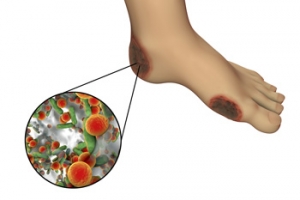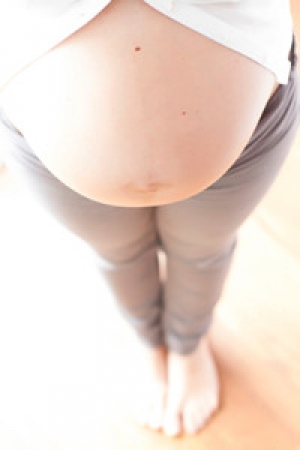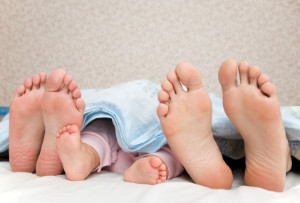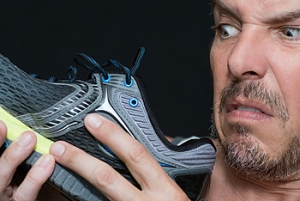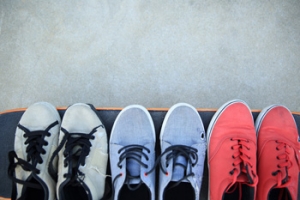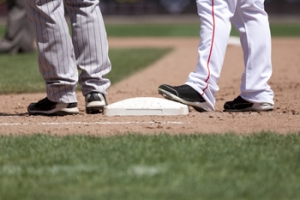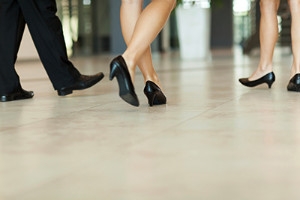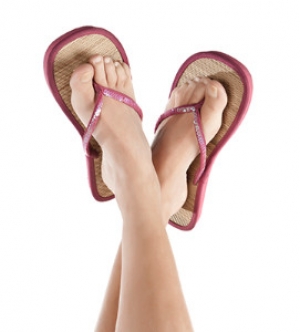Super User
Causes of Athlete’s Foot
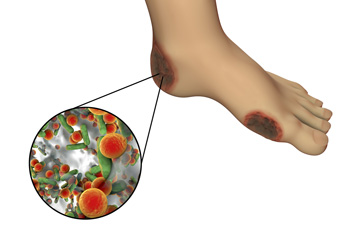 If you experience redness, itchiness, or blisters on the soles of the feet, you may have what is referred to as tinea pedis, or more commonly, athlete’s foot. It is caused by a fungal infection, and is can be extremely contagious. This type of fungus lives and thrives in moist places, and is commonly found in public showers, pools, and surrounding areas. It may affect the area between the toes in addition to the soles of the feet. There are several symptoms of athlete's foot that may be observed, including a rash that may appear, peeling skin on the soles of the feet, or an uncomfortable burning sensation. To prevent this condition from occurring it's suggested to wear appropriate shoes in public places, and to change your socks daily to avoid excessive perspiration between the toes. If you are experiencing chronic or severe athlete’s foot please schedule a consultation with a podiatrist.
If you experience redness, itchiness, or blisters on the soles of the feet, you may have what is referred to as tinea pedis, or more commonly, athlete’s foot. It is caused by a fungal infection, and is can be extremely contagious. This type of fungus lives and thrives in moist places, and is commonly found in public showers, pools, and surrounding areas. It may affect the area between the toes in addition to the soles of the feet. There are several symptoms of athlete's foot that may be observed, including a rash that may appear, peeling skin on the soles of the feet, or an uncomfortable burning sensation. To prevent this condition from occurring it's suggested to wear appropriate shoes in public places, and to change your socks daily to avoid excessive perspiration between the toes. If you are experiencing chronic or severe athlete’s foot please schedule a consultation with a podiatrist.
Athlete’s foot is an inconvenient condition that can be easily reduced with the proper treatment. If you have any concerns about your feet and ankles, contact Dr. John Branwell from Kearny, New Jersey. Our doctor will treat your foot and ankle needs.
Athlete’s Foot: The Sole Story
Athlete's foot, also known as tinea pedis, can be an extremely contagious foot infection. It is commonly contracted in public changing areas and bathrooms, dormitory style living quarters, around locker rooms and public swimming pools, or anywhere your feet often come into contact with other people.
Solutions to Combat Athlete’s Foot
- Hydrate your feet by using lotion
- Exfoliate
- Buff off nails
- Use of anti-fungal products
- Examine your feet and visit your doctor if any suspicious blisters or cuts develop
Athlete’s foot can cause many irritating symptoms such as dry and flaking skin, itching, and redness. Some more severe symptoms can include bleeding and cracked skin, intense itching and burning, and even pain when walking. In the worst cases, Athlete’s foot can cause blistering as well. Speak to your podiatrist for a better understanding of the different causes of Athlete’s foot, as well as help in determining which treatment options are best for you.
If you have any questions please feel free to contact our office located in Kearny, NJ . We offer the newest diagnostic and treatment technologies for all your foot and ankle needs.
How to Alleviate Swollen Ankles During Pregnancy
 If you have swollen ankles and feet during pregnancy, you are among the majority of the population that experience these uncomfortable side effects. An effective way to alleviate severely swollen ankles is to elevate your feet so they are higher than your heart. This technique makes it easier for additional fluids to drain from your legs that may have accumulated during pregnancy. Additionally, lying on your side while sleeping may result in less pressure the veins typically encounter. There can be physical changes that may occur, including feet that increase in size, or a change in the structure of the foot, which may affect the arch. Research has shown the importance of incorporating walking into your daily routine, periodically stretching your legs and including healthy foods in your daily food intake.
If you have swollen ankles and feet during pregnancy, you are among the majority of the population that experience these uncomfortable side effects. An effective way to alleviate severely swollen ankles is to elevate your feet so they are higher than your heart. This technique makes it easier for additional fluids to drain from your legs that may have accumulated during pregnancy. Additionally, lying on your side while sleeping may result in less pressure the veins typically encounter. There can be physical changes that may occur, including feet that increase in size, or a change in the structure of the foot, which may affect the arch. Research has shown the importance of incorporating walking into your daily routine, periodically stretching your legs and including healthy foods in your daily food intake.
Pregnant women with swollen feet can be treated with a variety of different methods that are readily available. For more information about other cures for swollen feet during pregnancy, consult with Dr. John Branwell from Kearny, New Jersey. Our doctor will attend to all of your foot and ankle needs.
What Foot Problems Can Arise During Pregnancy?
One problem that can occur is overpronation, which occurs when the arch of the foot flattens and tends to roll inward. This can cause pain and discomfort in your heels while you’re walking or even just standing up, trying to support your baby.
Another problem is edema, or swelling in the extremities. This often affects the feet during pregnancy but tends to occur in the later stages.
How Can I Keep My Feet Healthy During Pregnancy?
- Wearing orthotics can provide extra support for the feet and help distribute weight evenly
- Minimize the amount of time spent walking barefoot
- Wear shoes with good arch support
- Wear shoes that allow for good circulation to the feet
- Elevate feet if you experience swelling
- Massage your feet
- Get regular, light exercise, such as walking, to promote blood circulation to the feet
If you have any questions please feel free to contact our office located in Kearny, NJ . We offer the newest diagnostic and treatment technologies for all your foot and ankle needs.
Jorge Soler Suffers from Foot Fracture
 The Royals will have to play the next few weeks without their outfielder Jorge Soler. Soler recently fractured his left first metatarsal when he tripped running out of the batter’s box during a game. The injury hasn’t been ruled severe enough to require surgery, but the Royals are expected to re-evaluate the fracture soon. Fortunately, there is a possibility that the break may heal on its own. However, if Soler’s CT scan reveals a further separation of bones, surgery may be necessary. Soler is expected to be placed on the disabled list very soon and he will most likely be out of gameplay until August. Soler’s injury will be a monumental loss for an already struggling Kansas City Royals team. If you suspect that you have a fracture in your foot, you should consult with your podiatrist right away.
The Royals will have to play the next few weeks without their outfielder Jorge Soler. Soler recently fractured his left first metatarsal when he tripped running out of the batter’s box during a game. The injury hasn’t been ruled severe enough to require surgery, but the Royals are expected to re-evaluate the fracture soon. Fortunately, there is a possibility that the break may heal on its own. However, if Soler’s CT scan reveals a further separation of bones, surgery may be necessary. Soler is expected to be placed on the disabled list very soon and he will most likely be out of gameplay until August. Soler’s injury will be a monumental loss for an already struggling Kansas City Royals team. If you suspect that you have a fracture in your foot, you should consult with your podiatrist right away.
A broken foot requires immediate medical attention and treatment. If you need your feet checked, contact Dr. John Branwell from Kearny, New Jersey. Our doctor can provide the care you need to keep you pain-free and on your feet.
Broken Foot Causes, Symptoms, and Treatment
A broken foot is caused by one of the bones in the foot typically breaking when bended, crushed, or stretched beyond its natural capabilities. Usually the location of the fracture indicates how the break occurred, whether it was through an object, fall, or any other type of injury.
Common Symptoms of Broken Feet:
- Bruising
- Pain
- Redness
- Swelling
- Blue in color
- Numbness
- Cold
- Misshapen
- Cuts
- Deformities
Those that suspect they have a broken foot shoot seek urgent medical attention where a medical professional could diagnose the severity.
Treatment for broken bones varies depending on the cause, severity and location. Some will require the use of splints, casts or crutches while others could even involve surgery to repair the broken bones. Personal care includes the use of ice and keeping the foot stabilized and elevated.
If you have any questions please feel free to contact our office located in Kearny, NJ . We offer the newest diagnostic and treatment technologies for all your foot and ankle needs.
Why Should Children’s Feet Be Measured Frequently?
 Recent research has shown the importance of children walking barefoot or wearing shoes that have a soft sole when they are beginning to walk. This will enable the development of necessary muscle strength in addition to learning sensory information that originates from the soles of the feet. The feet should be properly measured once walking commences, to ensure a proper fit for shoes. Children’s feet grow rapidly, and frequent measuring of the feet will aid in choosing shoes that fit correctly. Foot conditions may develop as a result of poorly fitting shoes. These may include ingrown toenails, blisters, or the inability to walk correctly. When shopping for shoes, it’s important for the toes to have adequate room to move around and the front of the shoe should be wider than the heel. Most children are born with flat feet and arches will form when walking begins. Please consult with a podiatrist if your child appears to be flat-footed once walking has started.
Recent research has shown the importance of children walking barefoot or wearing shoes that have a soft sole when they are beginning to walk. This will enable the development of necessary muscle strength in addition to learning sensory information that originates from the soles of the feet. The feet should be properly measured once walking commences, to ensure a proper fit for shoes. Children’s feet grow rapidly, and frequent measuring of the feet will aid in choosing shoes that fit correctly. Foot conditions may develop as a result of poorly fitting shoes. These may include ingrown toenails, blisters, or the inability to walk correctly. When shopping for shoes, it’s important for the toes to have adequate room to move around and the front of the shoe should be wider than the heel. Most children are born with flat feet and arches will form when walking begins. Please consult with a podiatrist if your child appears to be flat-footed once walking has started.
The health of a child’s feet is vital to their overall well-being. If you have any questions regarding foot health, contact Dr. John Branwell of Kearny, New Jersey. Our doctor can provide the care you need to keep you pain-free and on your feet.
Tips for Keeping Children's Feet Healthy
- Make sure their shoes fit properly
- Look for any signs of in-toeing or out-toeing
- Check to see if they have Clubfoot (condition that affects your child’s foot and ankle, twisting the heel and toes inward) which is one of the most common nonmajor birth defects.
- Lightly cover your baby’s feet (Tight covers may keep your baby from moving their feet freely, and could prevent normal development)
- Allow your toddler to go shoeless (Shoes can be restricting for a young child’s foot)
- Cut toenails straight across to avoid ingrown toenails
- Keep your child’s foot clean and dry
- Cover cuts and scrapes. Wash any scratches with soap and water and cover them with a bandage until they’ve healed.
If you have any questions, please feel free to contact our office located in Kearny, NJ . We offer the newest diagnostic and treatment technologies for all your foot care needs.
Primary Hyperhidrosis vs. Secondary Hyperhidrosis
 Hyperhidrosis is a condition that causes a person to sweat excessively. People with this condition do not necessarily sweat due to heat or exercise. The condition worsens when people start to stress or get nervous. The purpose of sweat is to cool down the body when its temperature begins to rise. Primary hyperhidrosis occurs when the sweat glands simply become overactive. Secondary hyperhidrosis occurs due to a medical condition. People who have secondary hyperhidrosis often have an underlying medical condition such as thyroid problems, diabetes, menopausal hot flashes, or low blood sugar. If you are suffering from sweaty feet, you should wear clothes that don’t trap the sweat. You should look into antiperspirants to treat your condition, however if this does not work, you should try seeking help from a podiatrist.
Hyperhidrosis is a condition that causes a person to sweat excessively. People with this condition do not necessarily sweat due to heat or exercise. The condition worsens when people start to stress or get nervous. The purpose of sweat is to cool down the body when its temperature begins to rise. Primary hyperhidrosis occurs when the sweat glands simply become overactive. Secondary hyperhidrosis occurs due to a medical condition. People who have secondary hyperhidrosis often have an underlying medical condition such as thyroid problems, diabetes, menopausal hot flashes, or low blood sugar. If you are suffering from sweaty feet, you should wear clothes that don’t trap the sweat. You should look into antiperspirants to treat your condition, however if this does not work, you should try seeking help from a podiatrist.
If you are suffering from hyperhidrosis contact Dr. John Branwell of Kearny, New Jersey. Our doctor can provide the care you need to attend to all of your foot and ankle needs.
Hyperhidrosis of the Feet
Hyperhidrosis is a rare disorder that can cause people to have excessive sweating of their feet. This can usually occur all on its own without rigorous activity involved. People who suffer from hyperhidrosis may also experience sweaty palms.
Although it is said that sweating is a healthy process meant to cool down the body temperature and to maintain a proper internal temperature, hyperhidrosis may prove to be a huge hindrance on a person’s everyday life.
Plantar hyperhidrosis is considered to be the main form of hyperhidrosis. Secondary hyperhidrosis can refer to sweating that occurs in areas other than the feet or hands and armpits. Often this may be a sign of it being related to another medical condition such as menopause, hyperthyroidism and even Parkinson’s disease.
In order to alleviate this condition, it is important to see your doctor so that they may prescribe the necessary medications so that you can begin to live a normal life again. If this is left untreated, it is said that it will persist throughout an individual’s life.
A last resort approach would be surgery, but it is best to speak with your doctor to find out what may be the best treatment for you.
If you have any questions please feel free to contact our office located in Kearny, NJ . We offer the newest diagnostic and treatment technologies for all your foot and ankle needs.
Hyperhidrosis of the Feet
Hyperhidrosis of the feet, also termed plantar hyperhidrosis, is characterized by excessive sweating of the feet that can be onset by any cause, such as exercise, fever, or anxiety. Most people suffering from hyperhidrosis of the feet also experience hyperhidrosis of the hands, or palmar hyperhidrosis. Approximately 1-2% of Americans suffer from this disorder.
Sweating is a healthy process utilized by the body in order to cool itself and maintain a proper internal temperature, which is controlled by the sympathetic nervous system. In individuals with hyperhidrosis, the sympathetic nervous system works in "overdrive", producing far more sweat than is actually needed.
Plantar hyperhidrosis is considered primary hyperhidrosis. Secondary hyperhidrosis refers to excessive sweating that occurs in an area other than the feet, hands, or armpits, and this indicates that is related to another medical condition, such as menopause, hyperthyroidism, or Parkinson's disease.
Symptoms of hyperhidrosis of the feet can include foot odor, athlete's foot, infections, and blisters. Because of the continual moisture, shoes and socks can rot which creates an additional foul odor and can ruin the material, requiring shoes and socks to be replaced frequently. In addition to the physical symptoms, emotional health is often affected as this disorder can be very embarrassing.
If left untreated, hyperhidrosis will usually persist throughout an individual's life. However, there are several treatment options available. A common first approach to treating hyperhidrosis of the feet is a topical ointment. Aluminum chloride, an ingredient found in antiperspirants, can be effective at treating hyperhidrosis if used in high concentration and applied to the foot daily. Some individuals can experience relief this way, while others encounter extreme irritation and are unable to use the product. Another procedure is the use of Botulinum Toxin A, commonly referred to as Botox. This is injected directly into the foot, and is effective at minimizing the sweat glands in the injected area. These injections must be repeated every 4 to 9 months.
If these treatments are ineffective, oral prescription medications may be taken in an effort to alleviate the symptoms. Again, some will experience relief while others do not. Going barefoot reportedly provides relief for most sufferers.
A final approach to combating hyperhidrosis of the feet is through surgery. Surgery has been less successful on patients with plantar hyperhidrosis than on those with palmar hyperhidrosis. It is only recommended when sweating is severe and other treatments have failed to work. This kind of surgery usually involves going into the central nervous system, and cutting nerves to stop the transmission of signals telling the foot to sweat.
Problems That You May Not Know Your Shoes Are Causing
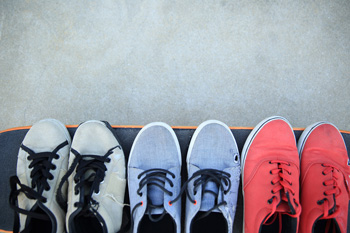 Improper shoe fitting can lead to many problems such as bunions, corns, and hammertoe. ill-fitting shoes can also lead to muscular imbalances in the body, which can eventually lead to hip and knee injuries. A perfectly fitting shoe should not have any excess material that may interfere with the foot’s natural motion. Many runners tend to wear shoes that are too small for their feet. If you are looking to purchase a new pair of shoes, be aware of the fact that your foot is at its widest at the toes, even though many shoes are not. You should also be mindful of the fact that your foot will spread up to half an inch in length when you are running. If you are experiencing problems with your feet due to poorly fitting shoes, you may want to schedule an appointment with your podiatrist.
Improper shoe fitting can lead to many problems such as bunions, corns, and hammertoe. ill-fitting shoes can also lead to muscular imbalances in the body, which can eventually lead to hip and knee injuries. A perfectly fitting shoe should not have any excess material that may interfere with the foot’s natural motion. Many runners tend to wear shoes that are too small for their feet. If you are looking to purchase a new pair of shoes, be aware of the fact that your foot is at its widest at the toes, even though many shoes are not. You should also be mindful of the fact that your foot will spread up to half an inch in length when you are running. If you are experiencing problems with your feet due to poorly fitting shoes, you may want to schedule an appointment with your podiatrist.
Finding a properly-fitting shoe is important in reducing injuries and preventing foot problems. For more information about treatment, contact Dr. John Branwell from Kearny, New Jersey. Our doctor will treat your foot and ankle needs.
Proper Shoe Fitting
A common concern when it comes to foot health, having properly fitted shoes can help prevent injuries to the foot. Out feet affect our posture and gait, which in turn affects the biomechanics and overall bodily structure. With 33 joints, 26 bones, and over 100 ligaments, the potential for serious injury is much greater than one realizes. Although the feet cease growth in adulthood, they still change shape as they mature. Here are some factors to consider when it comes to investing in proper fitting shoes:
- Be sure the shoes fit correctly right away
- Ensure the ball of your foot fits comfortably in the widest portion of the shoes
- Even though they may look fashionable, improper fitting shoes can either create adverse conditions or exacerbate existing ones you may already have
- Walk along a carpeted surface to ensure the shoes comfortably fit during normal activity
Keeping in mind how shoes fit the biomechanics of your body, properly-fitting shoes are vitally important. Fortunately, it is not difficult to acquire footwear that fits correctly. Be sure to wear shoes that support the overall structure of your body. Do your feet a favor and invest in several pairs of well-fitted shoes today.
If you have any questions please feel free to contact our office located in Kearny, NJ . We offer the newest diagnostic and treatment technologies for all your foot and ankle needs.
Blue Jays Outfielder Suffers Ankle Sprain
 Outfielder Lourdes Gurriel of the Toronto Blue Jays suffered both a knee contusion and an ankle sprain during a game against the Chicago White Sox. The injury occurred on a play where the outfielder twisted himself to avoid a tag at second base. When he attempted to slide, his left cleat caught on the dirt, forcing him to bend his knee and ankle awkwardly. After the play, it was obvious that Gurriel was in serious pain. Although initial x-rays were negative, Gurriel is expected to undergo an MRI for his ankle to determine if he suffered any further soft tissue damage.When asked about the outfielder, manager John Gibbons stated, “It looked like it was something very serious but he’s moving around okay. I’m sure it’ll tighten up on him and swell up on him. I think it’s already swelling, his ankle.” If you are experiencing symptoms from an ankle sprain and are seeking treatment, contact your podiatrist right away.
Outfielder Lourdes Gurriel of the Toronto Blue Jays suffered both a knee contusion and an ankle sprain during a game against the Chicago White Sox. The injury occurred on a play where the outfielder twisted himself to avoid a tag at second base. When he attempted to slide, his left cleat caught on the dirt, forcing him to bend his knee and ankle awkwardly. After the play, it was obvious that Gurriel was in serious pain. Although initial x-rays were negative, Gurriel is expected to undergo an MRI for his ankle to determine if he suffered any further soft tissue damage.When asked about the outfielder, manager John Gibbons stated, “It looked like it was something very serious but he’s moving around okay. I’m sure it’ll tighten up on him and swell up on him. I think it’s already swelling, his ankle.” If you are experiencing symptoms from an ankle sprain and are seeking treatment, contact your podiatrist right away.
Ankle sprains are common but need immediate attention. If you need your feet checked, contact Dr. John Branwell from Kearny, New Jersey. Our doctor can provide the care you need to keep you pain-free and on your feet.
How Does an Ankle Sprain Occur?
Ankle sprains take place when the ligaments in your ankle are torn or stretched beyond their limits. There are multiple ways that the ankle can become injured, including twisting or rolling over onto your ankle, putting undue stress on it, or causing trauma to the ankle itself.
What Are the Symptoms?
- Mild to moderate bruising
- Limited mobility
- Swelling
- Discoloration of the skin (depending on severity)
Preventing a Sprain
- Wearing appropriate shoes for the occasion
- Stretching before exercises and sports
- Knowing your limits
Treatment of a Sprain
Treatment of a sprain depends on the severity. Many times, people are told to rest and remain off their feet completely, while others are given an air cast. If the sprain is very severe, surgery may be required.
If you have suffered an ankle sprain previously, you may want to consider additional support such as a brace and regular exercises to strengthen the ankle.
If you have any questions please feel free to contact our office located in Kearny, NJ . We offer the newest diagnostic and treatment technologies for all your foot and ankle needs.
Steps to Maintain Foot Health While Working
 The feet and overall health of the body will benefit by performing daily foot care and this is especially true if you stand or walk for the majority of the day. Many jobs require standing for extended periods of time, and this may typically affect the general condition of the feet. Choosing to wear comfortable shoes may be beneficial to achieve maximum comfort in addition to maintaining a healthy weight, which may reduce pressure on the feet. Research has shown the importance of performing mild foot and ankle stretches throughout the day and this may prevent uncomfortable foot pain. When the work day has ended, it’s advised to wash and dry the feet thoroughly followed by utilizing a good moisturizing cream, which may prevent cracked heels. Please speak with a podiatrist for additional information on how to properly take care of your feet.
The feet and overall health of the body will benefit by performing daily foot care and this is especially true if you stand or walk for the majority of the day. Many jobs require standing for extended periods of time, and this may typically affect the general condition of the feet. Choosing to wear comfortable shoes may be beneficial to achieve maximum comfort in addition to maintaining a healthy weight, which may reduce pressure on the feet. Research has shown the importance of performing mild foot and ankle stretches throughout the day and this may prevent uncomfortable foot pain. When the work day has ended, it’s advised to wash and dry the feet thoroughly followed by utilizing a good moisturizing cream, which may prevent cracked heels. Please speak with a podiatrist for additional information on how to properly take care of your feet.
While working on the feet, it is important to take the proper care of them. For more information about working on your feet, contact Dr. John Branwell from Kearny, New Jersey. Our doctor will treat your foot and ankle needs.
Working on Your Feet
Standing on your feet for long periods of time can cause stress and pain in your feet. Your whole body may experience change in terms of posture, back pain, bunions, callouses and or plantar warts. There are ways to avoid these conditions with proper foot care, smart choices and correct posture.
Positive Changes
Negative heeled shoe – Choosing this shoe type places the heel slightly lower than the ball of the foot. These are great for overall foot health. Find shoes that fit you correctly.
Go barefoot – Our feet were not designed to be enclosed for all hours of the day. Try to periodically expose your feet to air.
Eliminate Pain
Foot Exercises – Performing simple exercises, incorporating yoga and doing stretches are beneficial. This will allow increased blood flow to the area and muscles of the foot.
Achilles tendon – Stretching the foot out flat on the floor will relax the calf muscles and tendon. These exercises can be performed almost anywhere. Make sure you add these exercises to your daily regimen.
With a little bit of this information and knowing more about foot health, you will notice changes. Foot stretches and proper footwear will help with pain and prevent further issues.
If you have any questions please feel free to contact our office located in Kearny, NJ . We offer the newest diagnostic and treatment technologies for all your foot and ankle needs.
Foot Conditions That May Occur as a Result of Wearing Flip Flops
 The type of footwear referred to as flip flops are popular summer shoes that are made of thin soles and typically are not meant to be worn for extended periods of time. Despite the fact that many people indulge in wearing these types of shoes, there may be moderate discomfort and symptoms that can be associated with them. These may include an achy feeling that may be present in the foot and ankle in addition to the formation of calluses and blisters. Other foot conditions that may develop as a result of wearing flip flops may be the development of bunions and hammertoes. The risk of injury may be increased from choosing to wear this type of shoe and this may occur as a result of a lack of stability. If you have questions pertaining to flip flops and would like additional information about the pros and cons for wearing this type of shoe, please schedule an appointment with a podiatrist who will be able to answer any questions you may have.
The type of footwear referred to as flip flops are popular summer shoes that are made of thin soles and typically are not meant to be worn for extended periods of time. Despite the fact that many people indulge in wearing these types of shoes, there may be moderate discomfort and symptoms that can be associated with them. These may include an achy feeling that may be present in the foot and ankle in addition to the formation of calluses and blisters. Other foot conditions that may develop as a result of wearing flip flops may be the development of bunions and hammertoes. The risk of injury may be increased from choosing to wear this type of shoe and this may occur as a result of a lack of stability. If you have questions pertaining to flip flops and would like additional information about the pros and cons for wearing this type of shoe, please schedule an appointment with a podiatrist who will be able to answer any questions you may have.
Flip-flops are not always the best choice of footwear. If you have any concerns about your feet or ankles, contact Dr. John Branwell from Kearny, New Jersey. Our doctor will assist you with all of your foot and ankle needs.
Flip-Flops and Feet
When the weather starts warming up, people enjoy wearing flip-flops. Flip-flops are comfortable, stylish, and easy to slip on and off; they're perfect for any summer beach goer. However, these shoes can cause harm to the feet.
How Can Flip-Flops Affect Me Long-Term?
- Ankle problems
- Hip problems
- Lower back problems
- Pain in the balls of the feet
- Problems with foot arches
- Changes in the way you walk
Are There Injuries Associated with Flip-Flops?
Yes. Since flip-flops are relatively weak and do not provide the same amount of support as sneakers, people who wear flip-flops regularly are more susceptible to injuries. On top of that, the open nature of the shoe makes your feet more prone to other problems, such as cuts and even infections. Common injuries and ailments include:
- Sprained ankles
- Blisters
- Infections
- Cuts and Scrapes
I like Wearing Flip-Flops. Are There Safe Alternatives?
When buying flip-flops, try to find ones that have sturdy soles and that are made of high-quality materials that will support for your feet. These flip-flops will cost more but will also last longer as a result.
If you have any questions please feel free to contact our office located in Kearny, NJ . We offer the newest diagnostic and treatment technologies for all your foot and ankle needs.
